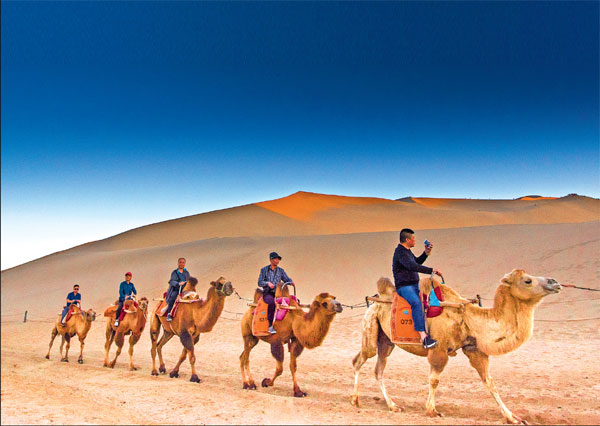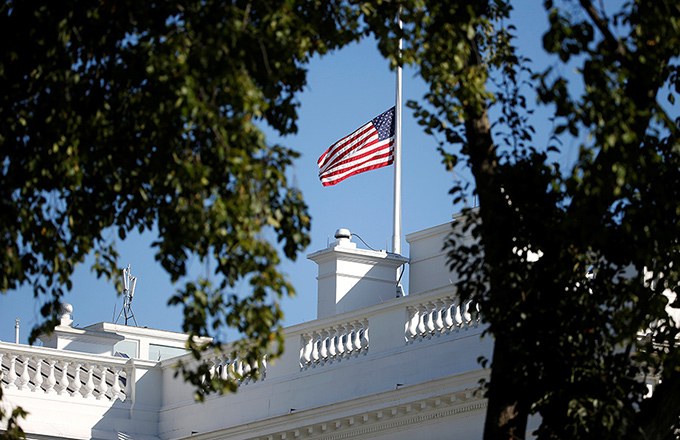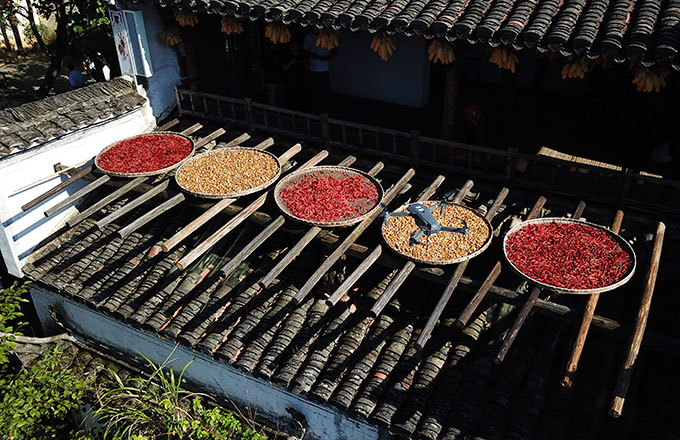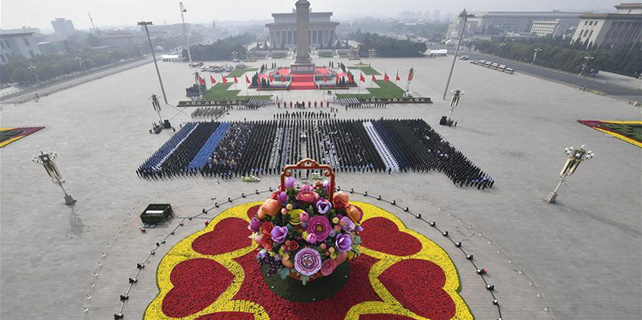Land of grapes
Dunhuang, with its large collection of Buddhist art, also offers agritourism and street food. Xu Lin reports.
A recent visit to Dunhuang, an important destination on the ancient Silk Road, revealed its awe-inspiring natural scenery and delicious food. The city located in Northwest China's Gansu province is striving to develop its agritourism. Hotel lobbies usually exhibit fruits such as grape, watermelon and peach, all grown locally as well. It's difficult to resist their temptation, so some visitors end up buying them before leaving the city. Other choices include raisins and dried fruits.
The government compensates the local farmers for displaying the fruits in the city's hotels for free tasting so as to promote them among travelers.
|
Visitors take camel rides to explore the charm of the sand dunes in Dunhuang, Gansu province. Qiu Lei / For China Daily |
The city held its annual grape tourism festival in summer, with activities such as forums and a fashion show.
"Dunhuang's advantage is tourism, and to combine agriculture with tourism will help more farmers to lift themselves out of poverty. We're striving to draw tourists to enjoy grapes and dishes made from local farm products," said Zhan Shunzhou, Party secretary of Dunhuang.
Annually, Dunhuang produces 200,000 tons of grapes, which are sold in more than 30 Chinese cities.
Zhan said the city administration is making efforts to standardize the grape industry, ranging from packaging to transportation, and focusing on promoting the fruit on e-commerce platforms.
About 60 kilometers from downtown is Yangguan town. Its pillar industries are grape-planting and tourism. With its ecology and difference in temperature from day to night, the grapes there are sweet and tasty.
The town's history of grape-planting can be traced back to the 1960s, and the industry started to grow evidently in 2000.
After visiting the Yangguan Pass, tourists can pick up grapes and have meals under grape vines at farmhouses.
Located on the ancient Silk Road, the Yangguan Pass is the last stop where Chinese merchants got stamps on their passports and other identification documents and left for foreign countries.
A famous Tang Dynasty (618-907) poem reads: "Out West past the Yangguan, old friends there'll be none."
Yueyaquan is a crescent-shaped lake in Mingsha Mountain, or Echoing-sand Mountain. It has never dried out since its origin in the Eastern Han Dynasty (25-220).
The lake is surrounded by traditional Chinese architecture with a history of more than 200 years.
The sand there is in five colors - red, yellow, blue, white and black. An echo can be heard in the sand when the wind blows.
Travelers can climb barefoot to the top of a large sand hill and get a panoramic view of the beautiful desert. It's exciting to sit on a plank and slide down from the top of the hill.
Tourists can also ride a camel for a relaxing trip. Or, they can ride a motorcycle with a coach or sit in an automobile to explore the vast desert and enjoy the excitement of what feels like a roller-coaster ride.
The Mogao Caves lie near the Crescent Lake. The caves contain one of the world's largest collections of Buddhist art. The 735 caves house more than 2,400 sculptures and about 45,000 square meters of murals.
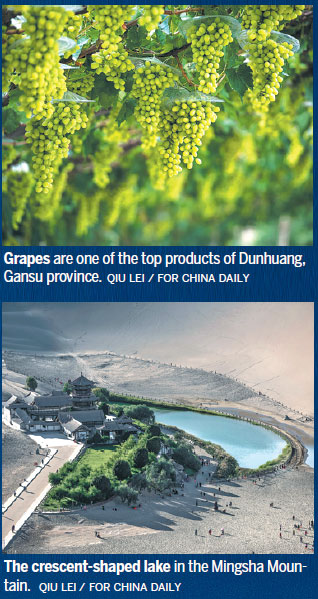
Since the year 366, skilled artisans have worked on the statues and frescoes for generations, reflecting the artistic styles of different dynasties.
With tourist numbers rising, the Dunhuang Research Academy has been working for years to digitize the artifacts for better preservation.
For example, e-dunhuang.com offers data on 30 caves. It is also easy to book tickets online. Visitors can watch two movies - one that introduces the caves and the other that uses 3-D technology to showcase the sculptures and murals in some caves where visitors cannot go due to their fragile state.
Then tourists are divided into groups and each group follows a tour guide to visit eight caves. Only with the guide's explanation is one able to fully understand the meaning of the artworks.
In Cave 249, for example, a simple sketch vividly demonstrates two hunters shooting arrows at a tiger and three goats respectively. In Cave 259, a Buddha statue is called "Mona Lisa in the East" due to its mysterious smile.
At night, visitors can watch Encore Dunhuang, a show produced by Wang Chaoge. Debuted last year, the show, which aims to give visitors a time-travel experience, has audience members walking around for the most part, rather than always sitting down.
The show's first part introduces ancient people of relevance to Dunhuang via soliloquies.
In 1900, Taoist priest Wang Yuanlu accidentally opened up a sealed cave and found tens of thousands of invaluable manuscripts in different languages.
A man plays him in the show and says he regrets selling many manuscripts to overseas explorers, but his purpose was to use the money to restore the caves.
After the show is over, visitors can head to a bustling night market in the city for midnight snacks.
The place is lined with restaurants that sell mutton skewered on a reddish stem of Chinese tamarisk, beef stewed with dough strips, cold vegetable dishes in sauce and beer. And, of course, tasty dairy products like yogurt for dessert.
After food comes music.
There are many singers in the night market who can play the guitar and sing popular songs at just 10 yuan ($ 1.5) a piece.
Contact the writer at xulin@chinadaily.com.cn
(China Daily 10/03/2017 page10)




